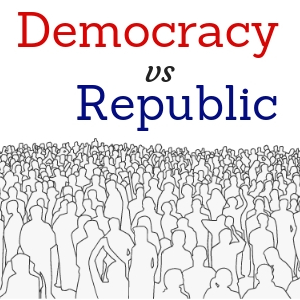Your cart is currently empty!

The Propaganda of Labels: Democracy vs. Republic
Here in the United States, terms like “democracy” and “republic” are often presented as powerful symbols, rallying cries for different political factions. Yet, the debate over these labels often obscures a fundamental truth: both terms accurately describe the American form of government. This article delves into how “democracy” and “republic” are used as propaganda tools and explores the reality that these terms, though politically charged, are fundamentally synonymous in the context of the United State’s governmental system.
Understanding the Terms
To dissect the propaganda surrounding “democracy” and “republic,” it’s important to work from an objective baseline definition.
- Democracy: Broadly, democracy refers to a system of government where power is vested in the people, who rule either directly or through freely elected representatives.
- Republic: A republic is a specific type of democracy where the country is considered a “public matter” (res publica), and the head of state and other officials are elected or appointed rather than inherited.
In essence, a republic is a representative democracy. The United States, therefore, embodies both concepts: it is a republic because it has an elected head of state and representative institutions, and it is a democracy because these institutions are elected by the people.
The Propaganda of Labels
Political discourse in the United States frequently weaponizes the terms “democracy” and “republic.” Here’s how:
- “Defending Democracy”: This phrase is often used by those who emphasize the democratic aspects of American governance, focusing on the rights of individuals to participate in free and fair elections. It is a rallying cry for those concerned with voter suppression, electoral integrity, and the broad inclusiveness of the political process.
- “Preserving the Republic”: On the other hand, this phrase is championed by those who emphasize the constitutional and institutional framework of the United States. It is often used by those who stress the importance of checks and balances, the rule of law, and protecting the republic from a potential tyranny of the majority.
Both sides use these terms to invoke powerful historical and ideological imagery. ‘Democracy’ is often portrayed as the guardian of individual freedoms and rights, while ‘republic’ is seen as the protector of structured, lawful governance. This is an ironic association, given that a republic is designed to protect against the tyranny of the majority, which inherently provides further protections for individual freedoms and civil liberties.
The problem arises when these terms are used to appeal to the emotions of less informed voters, who can be manipulated into a perspective that overlooks the potential for the majority to oppress the minority in a direct democracy. At the same time, they may also ignore the protections from institutional power offered by a representative democracy (republic).
Synonymous Reality
Despite the heated rhetoric, the reality is that both “democracy” and “republic” accurately describe the U.S. system of government. The United States is a representative democracy, where officials are elected to represent the people, embodying the principles of a republic through the utilization of Democratic mechanisms.
- Constitutional Framework: The U.S. Constitution establishes a system where power is divided among elected representatives and checks and balances are maintained, aligning with the concept of a republic.
- Electoral Process: The democratic element is evident in the regular, free, and fair elections that allow citizens to choose their representatives, a cornerstone of democratic governance.
Historical Perspective
The Founding Fathers of the United States deliberately chose to establish a republic, wary of the potential excesses of direct democracy. However, they embedded democratic principles within this framework. The Federalist Papers, particularly those written by James Madison, highlight the intent to create a government that balances the will of the majority with protection for individual rights and minority interests.
The Power of Words
The use of “democracy” and “republic” as propaganda highlights the power of words in shaping political narratives. By invoking these terms, political actors tap into deep-seated values and historical legacies, mobilizing supporters and framing debates.
However, this dichotomy often distracts from substantive policy discussions. Whether framed as defending democracy or preserving the republic, the underlying issues—such as electoral integrity, governance, and individual rights—remain fundamentally connected.
TL:DR
The terms “democracy” and “republic” are frequently used as propaganda tools in the United States, each carrying ideological weight and historical significance. Yet, in the context of the American form of government, both terms are correct and describe the same reality. The U.S. is a representative democracy and a republic, embodying the principles of both. Recognizing this can help move beyond the rhetorical battles and focus on the core values and issues that define American governance. Understanding the synonymous nature of these terms allows for a clearer, more unified perspective on what it means to uphold the principles of the United States government.
Here are some resources that will help you gain a robust understanding of the nuances of our system of governance:
- The Federalist Papers
- These essays, particularly those written by James Madison, Alexander Hamilton, and John Jay, provide in-depth insights into the intentions behind the U.S. Constitution and the balance between democracy and republicanism.
- Reference: The Federalist Papers, No. 10 and No. 51, James Madison.
- Encyclopædia Britannica: Democracy
- This comprehensive article explores the concept of democracy, its various forms, and its historical development.
- Reference: “Democracy.” Encyclopædia Britannica. Link
- Encyclopædia Britannica: Republic
- This article provides an overview of republics, their defining features, and examples from history.
- Reference: “Republic.” Encyclopædia Britannica. Link
- National Constitution Center
- An educational resource that offers detailed explanations of the U.S. Constitution, its amendments, and key constitutional concepts.
- Reference: National Constitution Center. Link
- Stanford Encyclopedia of Philosophy: Democracy
- An in-depth philosophical analysis of democracy, its principles, and its various interpretations.
- Reference: Christiano, Thomas. “Democracy.” Stanford Encyclopedia of Philosophy, 2018. Link
- Library of Congress: Federalist Papers
- The Library of Congress provides access to the full text of the Federalist Papers, offering insights into the foundational ideas of the American republic.
- Reference: Library of Congress. Link
- The Heritage Foundation: A Republic, If You Can Keep It
- An article discussing the balance between democracy and republicanism in the American context.
- Reference: Gash, Kenneth A. “A Republic, If You Can Keep It.” The Heritage Foundation, 2020. Link

Leave a Reply